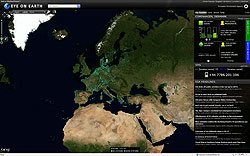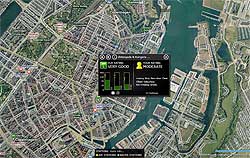REDMOND, Wash. – Dec. 9, 2009 – Microsoft is lifting Europe into the cloud to help its citizens train their gaze on planet Earth.
The new vantage point comes compliments of Eye on Earth, a joint project between Microsoft and the European Environment Agency (EEA) that is being shown at the United Nation’s 15th Climate Change Conference in Copenhagen (COP15), which kicked off Dec. 7. One of the first applications built on the Microsoft Windows Azure cloud-computing platform, the Eye on Earth portal provides real-time environmental information to the 500 million people who live in the EEA’s 32 member countries. It serves up that data in a visual format via Bing Maps.

At the Eye on Earth home page, visitors can click on links to sensors that show water or air quality at many locations across Europe.
By visualizing information such as air and water quality, Microsoft and the EEA hope to empower citizens and governments in Europe to understand and manage environmental change, says David Gay, a U.K.-based services program manager in Microsoft Services.
“If you asked someone how climate change might impact them, they might have a hard time pointing to a material effect on themselves or their family,” he says. “But if citizens can see the water quality where they take their children swimming, or see the quality of the air they’re breathing, that’s a material effect.”
Eye on Earth originally launched in May 2008 with WaterWatch, an application listing water quality for beaches and waterways throughout Europe. On Nov. 17 of this year the portal expanded to include AirWatch, which collects air quality information from thousands of observations throughout the EEA’s member countries. With this new update, Eye on Earth gets a fresh look and feel, and also becomes one of the first applications built on Microsoft Windows Azure and SQL Azure, Gay said.
The update to Eye on Earth came on the eve of the Climate Change Conference, which runs through December 18. As world leaders gather to discuss how to tackle climate change, Microsoft is sending a delegation of issue and technology experts to support COP15, said Claudia Toth, communications director for Global Strategic Accounts. Microsoft will participate in a series of briefings, events and partnerships to showcase for policymakers and other attendees the power of information technology to help address global challenges, she said.
The executive director of the EEA, Jacqueline McGlade, is featuring Eye on Earth during COP15 as an example of how IT can help solve big environmental problems. “As with any challenge, information on the environment has a key role to play,” McGlade said in an earlier interview. “With Eye on Earth, the EEA and Microsoft bring complex strands of information together into a single, simple-to-use and easy-to-understand application. As more people understand what’s happening in their area, more will contribute to solving environmental problems.”

The Eye on Earth portal provides real-time environmental information to millions of European citizens. Here is a snapshot of air and water conditions in Copenhagen, Denmark, location of the COP15 climate conference now in progress.
The EEA and Microsoft have been working together since July 2007, Toth said. They formed an official five-year partnership with the goal of delivering real-time environmental information to European Union citizens and raising awareness on environmental issues. But the EEA didn’t just want to deliver data and be done with it, Toth said. It wanted to create a two-way communication channel that citizens could use to update official data with what they observed on location. So far, users have sent 64,000 updates through the original Eye on Earth’s feedback feature, Gay says. The refreshed site now lets users leave structured feedback, he added. Another new feature lets users in EEA member countries query Eye on Earth on their mobile device and receive data through SMS.
By linking locally relevant information from near real-time public observations to scientific measurements, Eye on Earth creates an important new channel for policymakers and citizens across Europe to communicate environmental data, says Rob Bernard, chief environmental strategist for Microsoft.
“Addressing environmental change requires a comprehensive and global response,” Bernard said in a release about the application. “As a technology industry leader, Microsoft is committed to creating solutions for environmental sustainability and fostering connections between governments and citizens by applying leading-edge technology to help people visualize the impact of environmental challenges. Our partnership with the EEA is a powerful example of different organizations—public and private sector—combining their separate areas of expertise towards a shared challenge.”
Microsoft will continue to work with the EEA to ensure environmental data is available to all European Union citizens, Toth says. By the end of December, Eye on Earth will be available in 25 languages. It will gradually expand to include more data on themes such as biodiversity, she added.
“I think this is a significant example of how when Microsoft partners closely with organizations that are trying to address some of the largest social and economic challenges globally, we can help them do great things,” Toth says.




